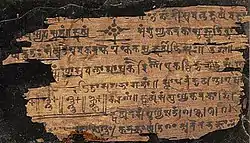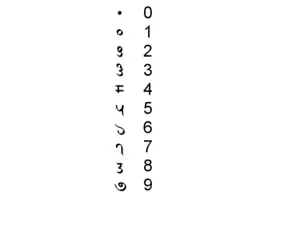Sharada script
The Śāradā, Sarada or Sharada script is an abugida writing system of the Brahmic family of scripts. The script was widespread between the 8th and 12th centuries in the northwestern parts of Indian Subcontinent (in Kashmir and neighbouring areas), for writing Sanskrit and Kashmiri.[4][1][5] Originally more widespread, its use became later restricted to Kashmir, and it is now rarely used except by the Kashmiri Pandit community for religious purposes.
| Śāradā 𑆯𑆳𑆫𑆢𑆳 | |
|---|---|
 'Sharada' in Sharada script | |
| Type | |
| Languages | Sanskrit, Kashmiri |
Time period | 700 CE –present (almost extinct)[1] |
Parent systems | |
Child systems | Takri Landa |
Sister systems | Siddhaṃ, Tibetan[2][3] |
| Direction | Left-to-right |
| ISO 15924 | Shrd, 319 |
Unicode alias | Sharada |
| U+11180–U+111DF | |
[a] The Semitic origin of the Brahmic scripts is not universally agreed upon. | |
| Brahmic scripts |
|---|
| The Brahmic script and its descendants |
It is a native script of Kashmir and is named after the goddess Śāradā or Saraswati, the goddess of learning and the main deity of the Sharada Peeth temple.[7]
History


The Bakhshali manuscript uses an early stage of the Sharada script.[4] The Sharda script was used in Afghanistan as well as in the Himachal region in India. In Afghanistan, the Kabul Ganesh has a 6th century Proto-Sharda inscription mentioning king Khingala.[8] At the historic Markula Devi Temple, the goddess Mahishamardini has a Sharada inscription of 1569 CE.[9]
From the 10th century onwards, regional differences started to appear between the Sharada script used in Punjab, the Hill States (partly Himachal Pradesh) and Kashmir. Sharada proper was eventually restricted to very limited ceremonial use in Kashmir, as it grew increasingly unsuitable for writing the Kashmiri language.[10] With the last known inscription dating to 1204 C.E., the early 13th century marks a milestone in the development of Sharada.[10] The regional variety in Punjab continued to evolve from this stage through the 14th century; during this period it starts to appear in forms closely resembling Gurmukhī and other Landa scripts. By the 15th century, Sharada had evolved so considerably that epigraphists denote the script at this point by a special name, Devāśeṣa.[10]
Letters
Independent vowel signs

Dependent vowel signs

Consonants

Image gallery
 Sharada vowels
Sharada vowels Sharada consonant signs
Sharada consonant signs Sanskrit (above; devanagari script) and Kashmiri language (below; sharada script)
Sanskrit (above; devanagari script) and Kashmiri language (below; sharada script)
Unicode
Śāradā script was added to the Unicode Standard in January, 2012 with the release of version 6.1.[11]
The Unicode block for Śāradā script, called Sharada, is U+11180–U+111DF:
| Sharada[1] Official Unicode Consortium code chart (PDF) | ||||||||||||||||
| 0 | 1 | 2 | 3 | 4 | 5 | 6 | 7 | 8 | 9 | A | B | C | D | E | F | |
| U+1118x | 𑆀 | 𑆁 | 𑆂 | 𑆃 | 𑆄 | 𑆅 | 𑆆 | 𑆇 | 𑆈 | 𑆉 | 𑆊 | 𑆋 | 𑆌 | 𑆍 | 𑆎 | 𑆏 |
| U+1119x | 𑆐 | 𑆑 | 𑆒 | 𑆓 | 𑆔 | 𑆕 | 𑆖 | 𑆗 | 𑆘 | 𑆙 | 𑆚 | 𑆛 | 𑆜 | 𑆝 | 𑆞 | 𑆟 |
| U+111Ax | 𑆠 | 𑆡 | 𑆢 | 𑆣 | 𑆤 | 𑆥 | 𑆦 | 𑆧 | 𑆨 | 𑆩 | 𑆪 | 𑆫 | 𑆬 | 𑆭 | 𑆮 | 𑆯 |
| U+111Bx | 𑆰 | 𑆱 | 𑆲 | 𑆳 | 𑆴 | 𑆵 | 𑆶 | 𑆷 | 𑆸 | 𑆹 | 𑆺 | 𑆻 | 𑆼 | 𑆽 | 𑆾 | 𑆿 |
| U+111Cx | 𑇀 | 𑇁 | 𑇂 | 𑇃 | 𑇄 | 𑇅 | 𑇆 | 𑇇 | 𑇈 | 𑇉 | 𑇊 | 𑇋 | 𑇌 | 𑇍 | 𑇎 | 𑇏 |
| U+111Dx | 𑇐 | 𑇑 | 𑇒 | 𑇓 | 𑇔 | 𑇕 | 𑇖 | 𑇗 | 𑇘 | 𑇙 | 𑇚 | 𑇛 | 𑇜 | 𑇝 | 𑇞 | 𑇟 |
Notes
| ||||||||||||||||
See also
- Lipi – writing scripts in Buddhist, Hindu and Jaina texts
- Sharada Peeth in Kashmir
References
- Singh, Upinder (2008). A History of Ancient and Early Medieval India: From the Stone Age to the 12th Century. Pearson Education India. p. 43. ISBN 9788131711200.
- Daniels, P.T. (January 2008). "Writing systems of major and minor languages". Cite journal requires
|journal=(help) - Masica, Colin (1993). The Indo-Aryan languages. p. 143.
- Selin, Helaine (2008). Encyclopaedia of the History of Science, Technology, and Medicine in Non-Western Cultures. Springer Science & Business Media. p. Bakhshali Manuscript entry. Bibcode:2008ehst.book.....S. ISBN 9781402045592.
- Sir George Grierson. (1916). "On the Sharada Alphabet". Journal of the Royal Asiatic Society, 17.
- For photograph of statue and details of inscription, see: Dhavalikar, M. K., "Gaņeśa: Myth and Reality", in: Brown 1991, pp. 50,63.
- "Pandits to visit Sharda temple". The Hindu. 17 May 2006. Retrieved 13 August 2012.
- From Persepolis to the Punjab: Exploring Ancient Iran, Afghanistan and Pakistan, Elizabeth Errington, Vesta Sarkhosh Curtis, British Museum Press, 2007 p. 96
- Observations on the Architecture and on a Carved Wooden Door of the Temple of Mirkulā Devī at Udaipur, Himachal Pradesh, Francesco Noci, East and West, Vol. 44, No. 1 (March 1994), pp. 99-114
- Pandey, Anshuman (2009-03-25). "N3545: Proposal to Encode the Sharada Script in ISO/IEC 10646" (PDF). Working Group Document, ISO/IEC JTC1/SC2/WG2.
- Pandey, Anshuman (2009-08-05). "L2/09-074R2: Proposal to encode the Sharada Script in ISO/IEC 10646" (PDF).
External links
- Saerji. (2009). Śāradā script: Akṣara List of the Manuscript of Abhidharmadīpa (ca. the 11th Century). Research Institute of Sanskrit Manuscripts & Buddhist Literature, Peking University.
- ancientscripts.com
- Download Noto Sans Sharada, a Sharada font by Google.
- Prevalence of the Śāradā Script in Afghanistan

